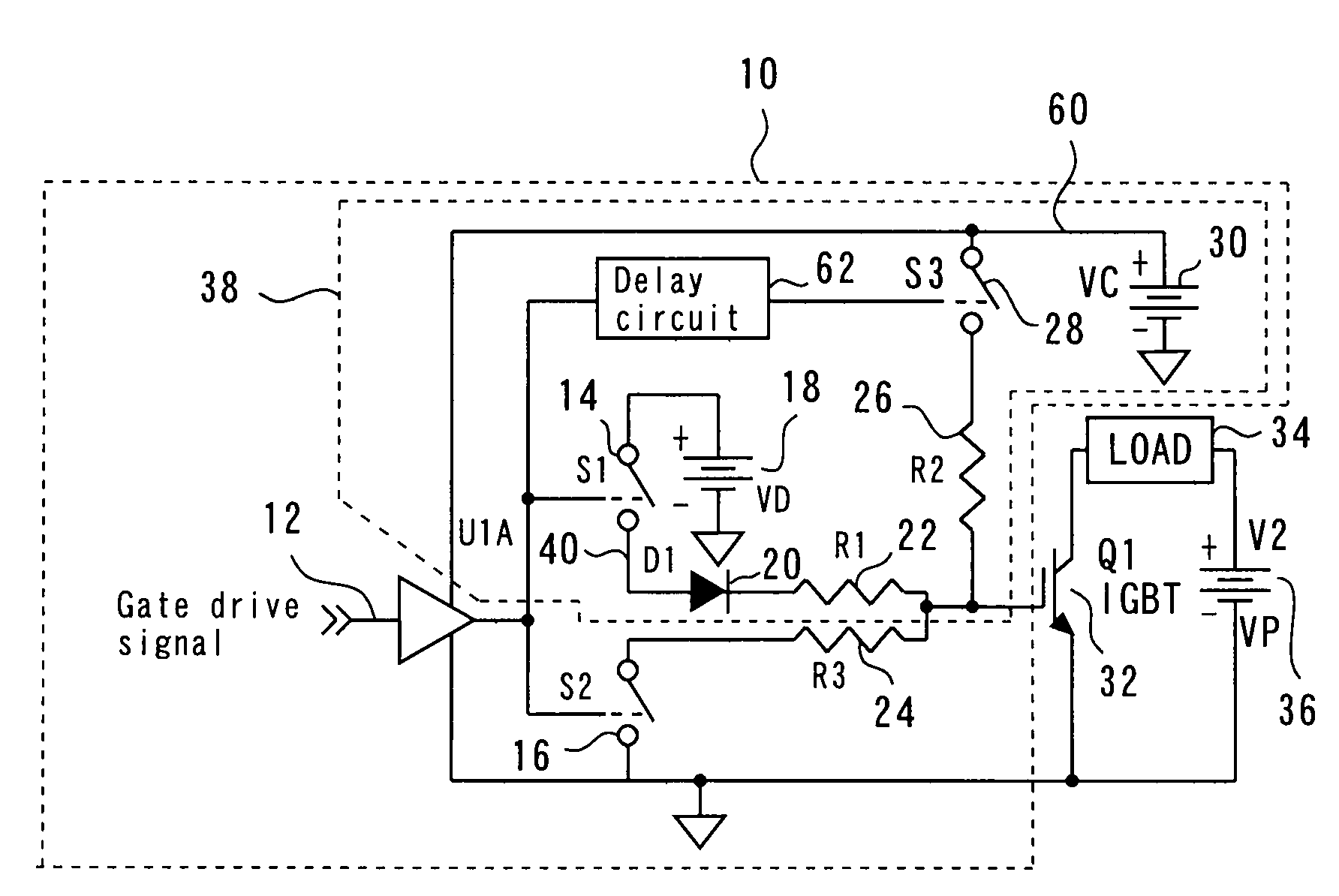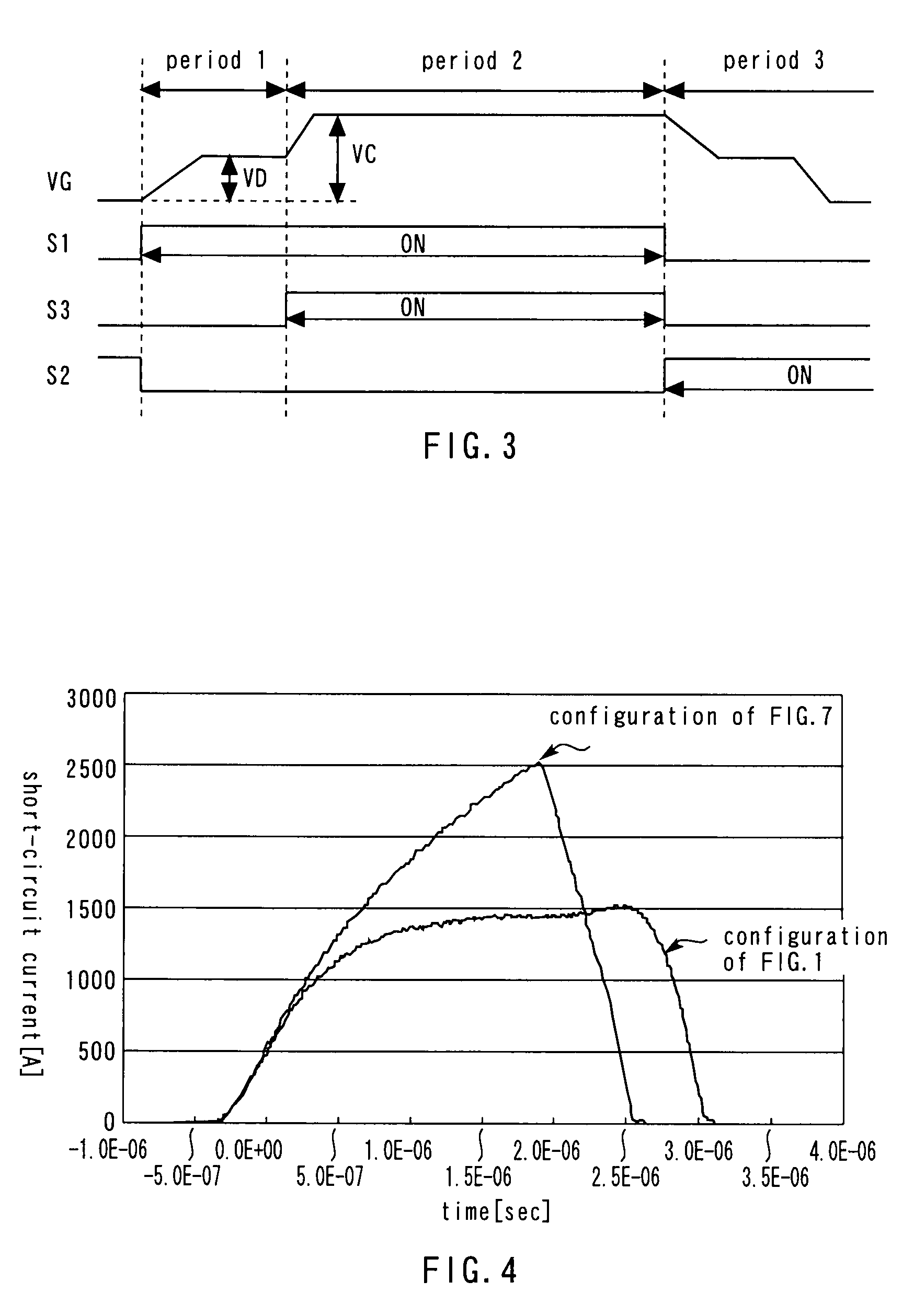Gate drive circuit
a drive circuit and gate technology, applied in logic circuit coupling/interface arrangement, pulse generator, pulse technique, etc., can solve the problems of device degradation, device transition to an off state, device voltage further decrease, etc., to prevent an increase in steady state loss, the switching characteristics of the power semiconductor device can be arbitrarily set, and the resistance to short circuiting is sufficient.
- Summary
- Abstract
- Description
- Claims
- Application Information
AI Technical Summary
Benefits of technology
Problems solved by technology
Method used
Image
Examples
first embodiment
[0069]A first embodiment of the present invention provides a gate drive circuit that can drive a power switching device in such a way as to optimize its turn-on characteristics. FIG. 1 is a circuit diagram illustrating the configuration of this gate drive circuit (10). In FIG. 1, the gate drive circuit 10 drives the gate of a power switching device 32. The power switching device 32 may be a voltage driven bipolar transistor, a MOSFET, etc. The following description of the present embodiment assumes that the device 32 is an IGBT (Insulated Gate Bipolar Transistor) and constitutes a portion of an arm (a bridge or shunt arm).
[0070]The gate drive circuit 10 includes a turn-on side circuit 38 for turning on the power switching device 32. The turn-on side circuit 38 includes a first turn-on side power supply circuit 50 and a second turn-on side power supply circuit 52, as shown in FIG. 2. First the first turn-on side power supply circuit 50 will be described with reference to FIG. 1. The ...
second embodiment
[0102]A second embodiment of the present invention provides a gate drive circuit that can drive a power switching device in such way as to optimize its turn-off switching characteristics. FIG. 11 is a diagram illustrating the configuration of this gate drive circuit (100). Referring to FIG. 11, the gate drive circuit 100 includes a turn-off side circuit 102 for turning off a power switching circuit 32. Further, the gate drive circuit 100 also includes a turn-on side circuit (which does not overlap the turn-off side circuit 102) for turning on the power switching circuit 32. It should be noted that the power switching device 32 is set to a steady on state by turning on a turn-on side switch 132 in the turn-on side circuit and thereby applying a voltage VC to the gate of the power switching device 32.
[0103]FIG. 12 is a diagram illustrating the turn-off side circuit 102 described with reference to FIG. 11. The turn-off side circuit 102 includes a first turn-off side power supply circui...
third embodiment
[0118]A third embodiment of the present invention provides a gate drive circuit that includes a simple, low cost circuit for changing the first turn-on voltage. This gate drive circuit differs from that shown in FIG. 1 in that the first turn-on voltage 18 is replaced by the turn-on side variable voltage circuit 300 shown in FIG. 16. That is, according to the present embodiment, the first turn-on voltage is supplied from this turn-on side variable voltage circuit 300 instead of the first turn-on voltage source 18. The output terminal OUTPUT of the turn-on side variable voltage circuit 300 is connected to the first turn-on wiring 40. The turn-on side variable voltage circuit 300 supplies the first turn-on voltage (also denoted by Vout herein), as described above. It should be noted that the configuration and operation of the gate drive circuit of the present embodiment are similar to those of the gate drive circuit of the first embodiment except that the first turn-on voltage is suppl...
PUM
 Login to View More
Login to View More Abstract
Description
Claims
Application Information
 Login to View More
Login to View More - R&D
- Intellectual Property
- Life Sciences
- Materials
- Tech Scout
- Unparalleled Data Quality
- Higher Quality Content
- 60% Fewer Hallucinations
Browse by: Latest US Patents, China's latest patents, Technical Efficacy Thesaurus, Application Domain, Technology Topic, Popular Technical Reports.
© 2025 PatSnap. All rights reserved.Legal|Privacy policy|Modern Slavery Act Transparency Statement|Sitemap|About US| Contact US: help@patsnap.com



